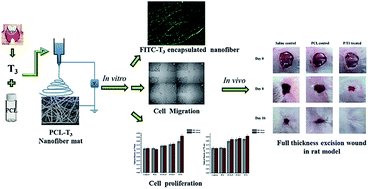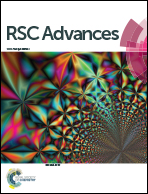Fabrication of a triiodothyronine incorporated nanofibrous biomaterial: its implications on wound healing†
Abstract
With rising incidents of non-healing chronic wounds, functional restoration of the organs after a major wound insult is an essential requisite. The delivery of endogenous molecules through nanomaterials for supporting healing of such wounds has gained impetus in the past decade. Triiodothyronine (T3) is a hormone that exerts its activity at various target organs and is reported to play a critical role in repair and regeneration of tissues after injury. The encapsulation of T3 in nanofibers and its sustained release to enable wound healing has been attempted for the first time in this work. The physico-chemical characterization confirmed the encapsulation and uniform distribution of the hormone in the nanofiber. Functional characterization of the composite nanofibers revealed the significant positive influence of the T3-entrapped nanofibers on the proliferation and migration of skin cells. Consistent with the in vitro results, application of the composite nanofibers on full thickness excisional wounds in rat model (in vivo) confirmed the potential of the hormone in accelerating the rate of wound closure. Thus this work reveals the effect of prolonged sustained delivery of T3 from nanofibers which might promote the healing of chronic wounds.


 Please wait while we load your content...
Please wait while we load your content...